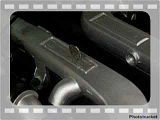I've noticed that a lot of people confuse themselves between a Inline 4 to a V4. It's not a V for a reason don't they know? So let me educate some of you guys that doesn't know the difference between the different layouts of the gas powered engines used today.
Inline engines are when Pistons are "lined up" in front of each other. This is a great layout because it gives more room in the engine bay for mechanics to use and more reliable, using less parts and fuel efficiency.
V Engines are when pistons are next to each other side by side at a 60 degree angle creating a "V" shape when looked at front head on. Hence why it's a V engine. It uses more parts but it creates more power since there are two seperate valve intake chambers pumping in more fuel at the same time compared to the inline engines
Flat Engines or Boxer's engines are when pistons lie next to each other. Instead of the usual vertical positioning of the pistons, they lie down next to each other side by side horizontally. If you look at it, it's like interlocking your fingers together. This is to give better performance and more room around the engine bay. Today, only two manufacturers solely devote themselves to these engines, Porsche and Subaru.
Rotary engines uses "rotaries" instead of pistons. This triangular shaped disc is very unique since it doesn't have any pistons in the engine. The rotary is quite unique since it spins to combust the fuel inside the chambers. It puts out better performance and reliability and fuel economy is quite low. Unlike pistons where you replace them after 110,000+ miles when cracked, the rotaries have tiny blades on the three points. These blades actually slides against the chamber walls causing friction and eventually wearing out the blades which in total doesn't create a tight seal when combusting fuel. THese are actually required to be changed every 30,000 miles or so. Mazda is known today as the only manufacturer to use the rotary engines on their performance model lineup, the RXs. RX-1 to RX-8. Also the Eunos Cosmo also sported a two rotary wankel engine back in early 90s.
If you guys have more to input, so ahead, this thread to help those who are confused about the engine piston layouts and all. :clap:
Inline engines are when Pistons are "lined up" in front of each other. This is a great layout because it gives more room in the engine bay for mechanics to use and more reliable, using less parts and fuel efficiency.
V Engines are when pistons are next to each other side by side at a 60 degree angle creating a "V" shape when looked at front head on. Hence why it's a V engine. It uses more parts but it creates more power since there are two seperate valve intake chambers pumping in more fuel at the same time compared to the inline engines
Flat Engines or Boxer's engines are when pistons lie next to each other. Instead of the usual vertical positioning of the pistons, they lie down next to each other side by side horizontally. If you look at it, it's like interlocking your fingers together. This is to give better performance and more room around the engine bay. Today, only two manufacturers solely devote themselves to these engines, Porsche and Subaru.
Rotary engines uses "rotaries" instead of pistons. This triangular shaped disc is very unique since it doesn't have any pistons in the engine. The rotary is quite unique since it spins to combust the fuel inside the chambers. It puts out better performance and reliability and fuel economy is quite low. Unlike pistons where you replace them after 110,000+ miles when cracked, the rotaries have tiny blades on the three points. These blades actually slides against the chamber walls causing friction and eventually wearing out the blades which in total doesn't create a tight seal when combusting fuel. THese are actually required to be changed every 30,000 miles or so. Mazda is known today as the only manufacturer to use the rotary engines on their performance model lineup, the RXs. RX-1 to RX-8. Also the Eunos Cosmo also sported a two rotary wankel engine back in early 90s.
If you guys have more to input, so ahead, this thread to help those who are confused about the engine piston layouts and all. :clap:







